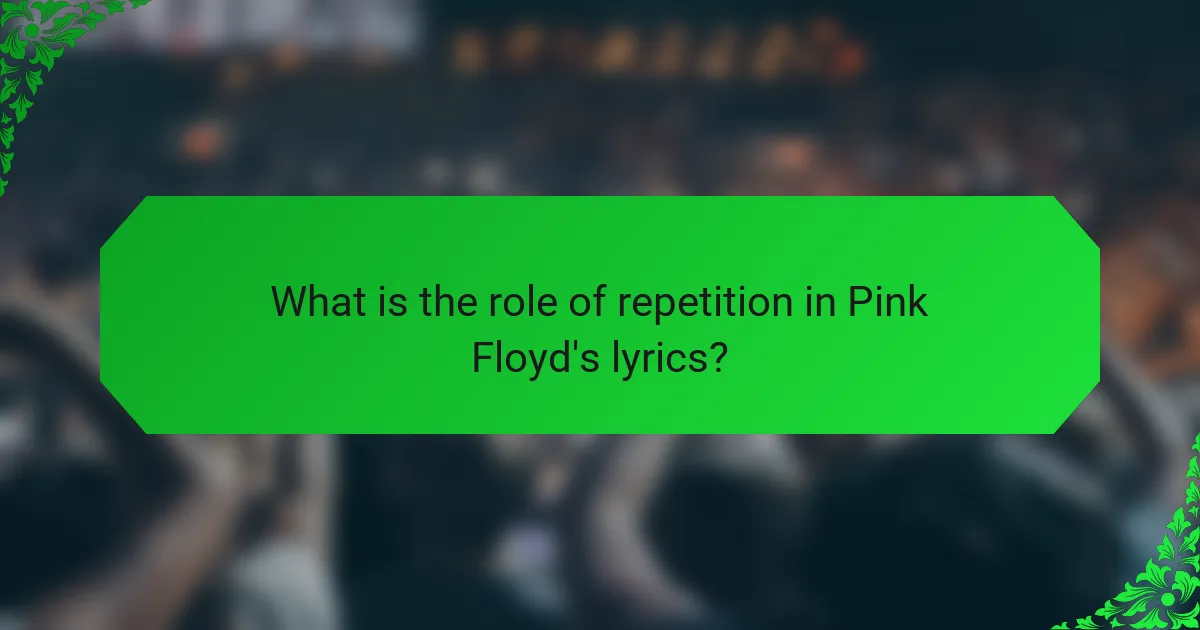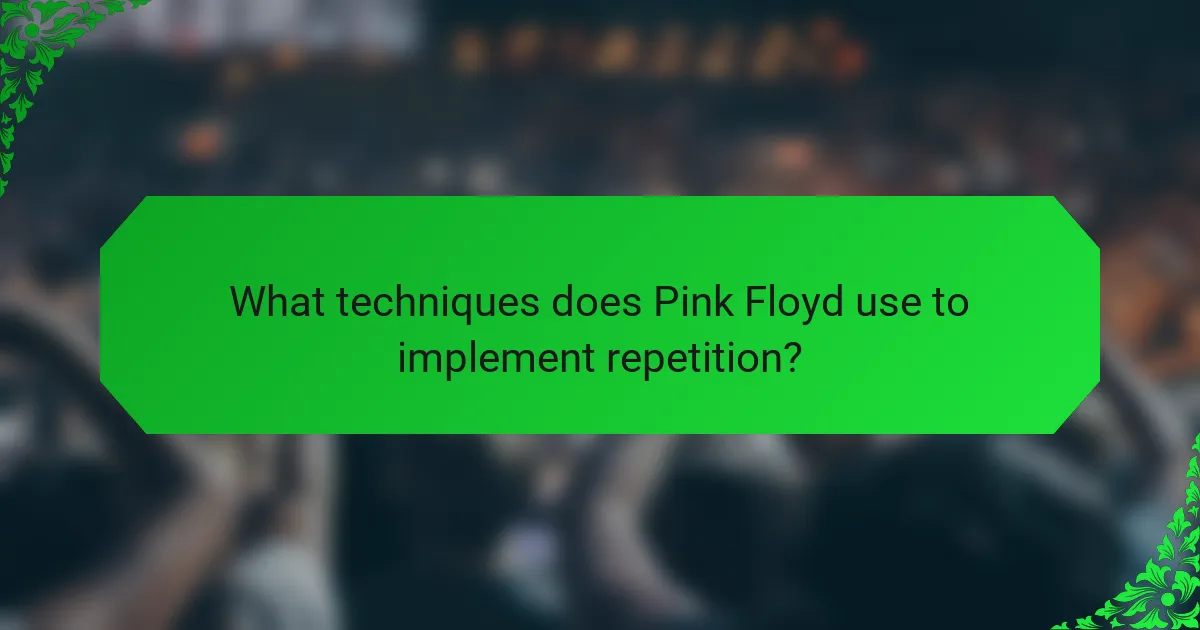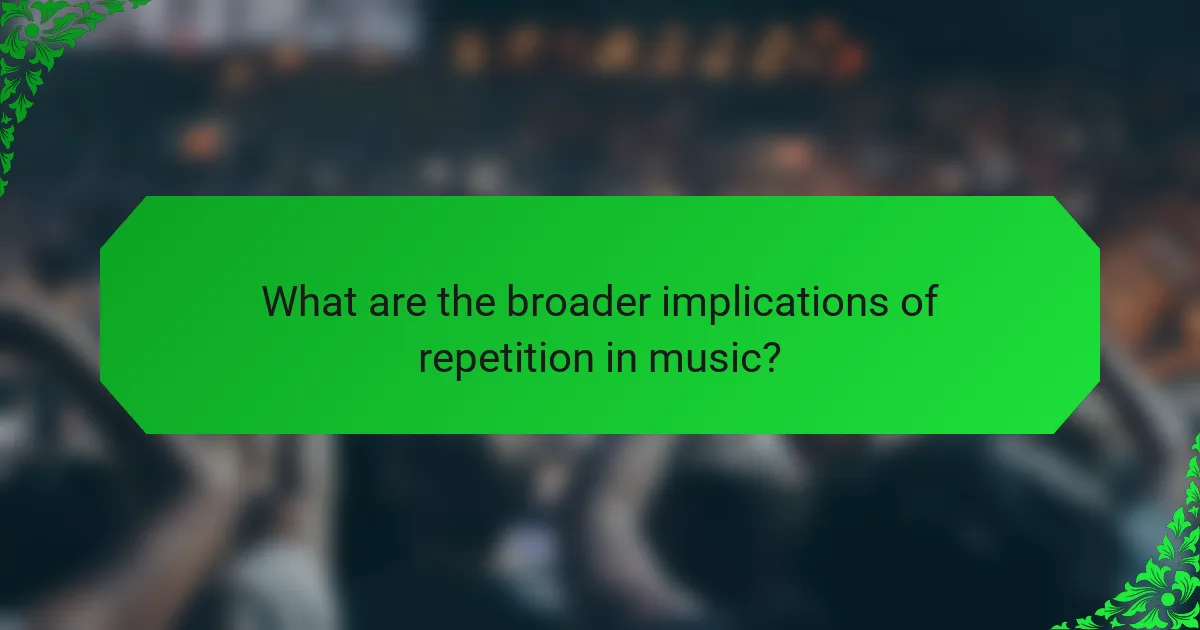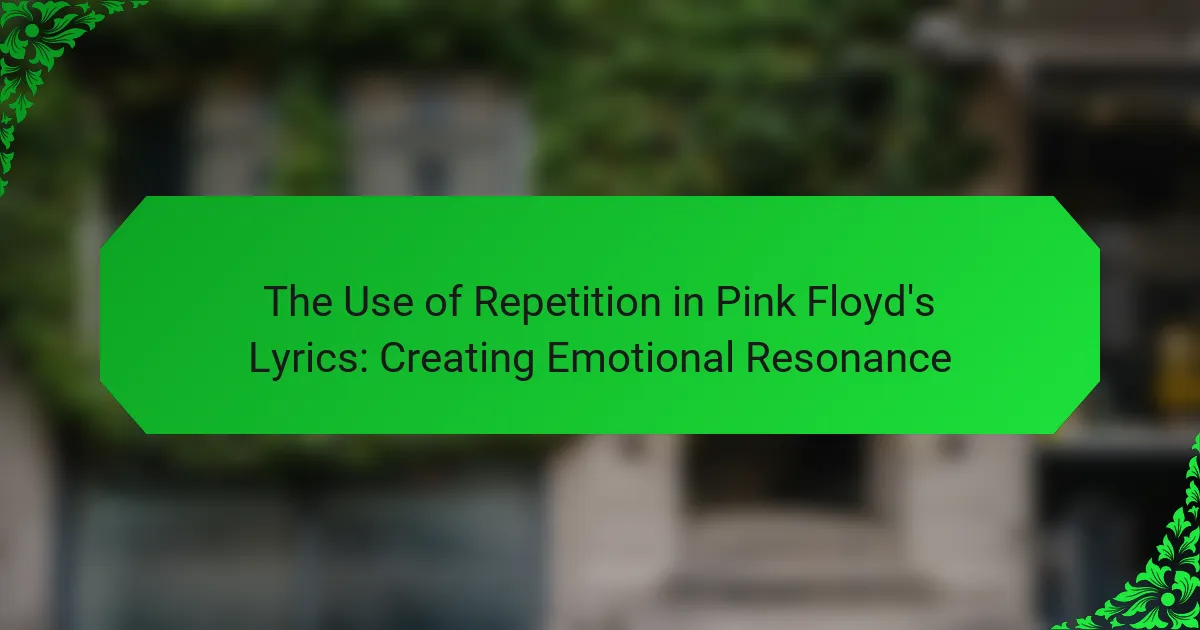The article explores the use of repetition in Pink Floyd’s lyrics, highlighting how this technique enhances emotional resonance and emphasizes key themes. It discusses various methods of repetition, including lyrical, musical motifs, and rhythmic patterns, which collectively deepen listeners’ connections to the music. The analysis includes specific examples from iconic songs like “The Wall,” “Comfortably Numb,” and “Money,” illustrating how repetition evokes feelings of isolation, longing, and reflection. Overall, the article examines how repetition shapes the listener’s experience and interpretation of Pink Floyd’s work, reinforcing thematic elements and increasing emotional engagement.

What is the role of repetition in Pink Floyd’s lyrics?
Repetition in Pink Floyd’s lyrics serves to enhance emotional resonance. It creates a sense of urgency and emphasizes key themes. For instance, the repeated phrases in “The Wall” underscore feelings of isolation and despair. This technique draws listeners deeper into the narrative. Repetition also reinforces the musical structure, making certain lines more memorable. Songs like “Comfortably Numb” utilize repetition to evoke a haunting quality. Overall, this stylistic choice deepens the listener’s connection to the music and its messages.
How does repetition enhance emotional resonance in their music?
Repetition enhances emotional resonance in music by reinforcing key themes and feelings. In Pink Floyd’s lyrics, repeated phrases create a sense of familiarity. This familiarity allows listeners to connect more deeply with the emotions conveyed. For example, the repetition of specific lines can evoke nostalgia or longing. Research shows that repetition in music can lead to increased emotional engagement. A study by Levitin and Tirovolas (2009) found that familiar musical patterns elicit stronger emotional responses. Thus, Pink Floyd effectively uses repetition to deepen the listener’s emotional experience.
What specific lyrics exemplify the use of repetition?
Lyrics from Pink Floyd’s song “Another Brick in the Wall, Part 2” exemplify the use of repetition. The phrase “We don’t need no education” is repeated multiple times throughout the song. This repetition emphasizes the theme of rebellion against authoritarian control in education. Additionally, the line “Hey! Teacher! Leave them kids alone!” is also repeated, reinforcing the emotional impact of the message. These specific lyrics effectively illustrate how repetition can create a strong emotional resonance in music.
How does the context of the songs influence the impact of repetition?
The context of songs significantly influences the impact of repetition. Repetition in lyrics can enhance emotional connection when aligned with thematic elements. For instance, in Pink Floyd’s “The Wall,” repeated phrases underline feelings of isolation and despair. This repetition reinforces the narrative, making the listener more engaged. Contextual elements, such as melody and instrumentation, also amplify the emotional weight of repeated lines. Research shows that songs with strong contextual themes can evoke deeper emotional responses. In summary, the interplay between context and repetition shapes the listener’s experience profoundly.
Why is emotional resonance important in Pink Floyd’s music?
Emotional resonance is crucial in Pink Floyd’s music because it enhances listener connection. The band’s lyrics often explore deep themes like alienation, loss, and existentialism. This emotional depth invites listeners to reflect on their own experiences. For instance, songs like “Comfortably Numb” evoke feelings of isolation and disconnection. The use of repetition in their lyrics reinforces these emotions, making messages more impactful. Research shows that emotional engagement in music can lead to stronger memory retention and personal relevance. This connection is a key reason why Pink Floyd’s music remains influential and timeless.
What psychological effects does music repetition have on listeners?
Music repetition creates psychological effects such as increased familiarity and emotional engagement. Familiarity leads to a sense of comfort and predictability. This can enhance listeners’ enjoyment and connection to the music. Emotional engagement occurs as repeated phrases resonate with listeners on a deeper level. Research shows that repetition can enhance memory retention of lyrics and melodies. A study by Szpunar et al. (2013) found that repeated exposure to music aids in recall and emotional response. Additionally, repetition can induce a trance-like state, promoting relaxation and introspection. Overall, music repetition significantly influences listeners’ psychological experiences.
How does repetition contribute to the storytelling aspect of their lyrics?
Repetition enhances the storytelling aspect of Pink Floyd’s lyrics by reinforcing key themes and emotions. It creates a rhythmic structure that draws listeners into the narrative. Repeated phrases evoke strong emotional responses, making the message more memorable. This technique emphasizes pivotal moments in the story, allowing listeners to connect deeply. For example, in “Another Brick in the Wall,” the repetition of the phrase underscores the theme of isolation. Such repetition creates a sense of urgency and highlights the emotional weight of the lyrics. Overall, it serves to unify the narrative, making the storytelling more impactful and resonant.

What techniques does Pink Floyd use to implement repetition?
Pink Floyd uses various techniques to implement repetition in their music. One technique is lyrical repetition, where phrases or lines are echoed throughout a song. This creates a sense of familiarity and emotional weight. Another technique is musical motifs, where specific melodies or chord progressions recur at different points. This reinforces thematic elements in their work. Additionally, they utilize rhythmic repetition, creating a consistent beat or pattern that enhances the listener’s experience. For example, the song “Money” features a repeated bass line that drives the song forward. These techniques collectively contribute to the emotional resonance found in Pink Floyd’s lyrics.
How does the structure of their songs incorporate repetitive elements?
The structure of Pink Floyd’s songs incorporates repetitive elements through recurring musical phrases and lyrical motifs. This repetition creates a sense of familiarity and emotional depth. For example, songs like “Comfortably Numb” feature repeated guitar solos and lyrics that reinforce the song’s themes. Additionally, tracks such as “Another Brick in the Wall” use repetitive choruses to emphasize social commentary. The use of repetition in their work enhances listener engagement and emotional impact. Research shows that repetitive elements can evoke strong emotional responses, aligning with Pink Floyd’s intent to connect with their audience.
What are the different forms of repetition used in their lyrics?
Repetition in Pink Floyd’s lyrics includes anaphora, epistrophe, and refrains. Anaphora involves repeating a word or phrase at the beginning of consecutive lines or verses. For example, in “The Wall,” the phrase “We don’t need” emphasizes the theme of isolation. Epistrophe is the repetition of a word or phrase at the end of lines. This technique can be seen in “Time,” where the ending phrases create a haunting echo. Refrains are repeated lines or phrases throughout a song, enhancing its emotional impact. In “Wish You Were Here,” the title line serves as a poignant reminder of loss. Each form of repetition contributes to the overall emotional resonance of the lyrics.
How does instrumentation complement lyrical repetition?
Instrumentation enhances lyrical repetition by adding depth and emotional weight. The interplay between music and lyrics creates a more immersive experience. Instrumental layers can mirror the themes expressed in the lyrics. For example, in Pink Floyd’s work, guitar riffs often echo repeated phrases. This reinforces the message and evokes a stronger emotional response. Additionally, dynamic changes in instrumentation can emphasize moments of lyrical repetition. Such contrasts highlight the significance of the repeated lines. Overall, instrumentation serves to amplify the impact of lyrical repetition, creating a cohesive emotional narrative.
In what ways do different albums showcase repetition?
Different albums showcase repetition through lyrical motifs, musical phrases, and thematic elements. Pink Floyd’s albums often feature repeated phrases that enhance emotional impact. For example, “The Wall” uses the phrase “We don’t need no education” to emphasize rebellion. Similarly, “Wish You Were Here” repeats the line “How I wish, how I wish you were here” to convey longing. Musical repetition is also prevalent, as seen in the recurring guitar riffs in “Comfortably Numb.” Thematic repetition links songs across albums, reinforcing overarching narratives. This technique creates a sense of continuity and deepens listener engagement. Repetition in Pink Floyd’s work is a powerful tool that evokes strong emotional responses.
What are notable examples from “The Wall” that highlight repetition?
Notable examples from “The Wall” that highlight repetition include the phrases “We don’t need no education” and “All in all, it’s just another brick in the wall.” The first phrase is repeated multiple times in the song “Another Brick in the Wall, Part 2.” This repetition emphasizes the theme of rebellion against oppressive education systems. The second phrase recurs throughout the album, symbolizing the accumulation of experiences that contribute to emotional isolation. These repeated lines create a haunting resonance that reinforces the album’s overarching narrative of alienation and despair.
How does “Dark Side of the Moon” utilize repetition for emotional depth?
“Dark Side of the Moon” utilizes repetition to enhance emotional depth through lyrical motifs and musical phrases. Repeated phrases create a sense of urgency and familiarity. For example, the phrase “All that you touch” recurs in the song “Breathe,” emphasizing themes of connection and loss. This repetition evokes feelings of nostalgia and introspection. Additionally, musical repetition in tracks like “Time” reinforces the cyclical nature of life. The consistent return to certain musical themes deepens the emotional impact. Overall, repetition serves to unify the album’s themes and resonate with listeners on a profound level.

What are the broader implications of repetition in music?
Repetition in music serves to reinforce themes and enhance emotional impact. It creates familiarity, allowing listeners to connect more deeply with the material. This technique can evoke memories and feelings, making the experience more relatable. Studies show that repeated musical phrases can lead to increased emotional engagement. For example, Pink Floyd employs repetition to create a sense of longing and reflection in their lyrics. This method can also facilitate memorization, making songs more memorable. Overall, repetition shapes the listener’s experience and interpretation of music significantly.
How does repetition in Pink Floyd’s lyrics compare to other artists?
Repetition in Pink Floyd’s lyrics is often more thematic and philosophical compared to other artists. Pink Floyd uses repetition to evoke deep emotional responses and reinforce complex concepts. For example, in “The Wall,” recurring phrases emphasize themes of isolation and despair. This contrasts with many pop artists who use repetition primarily for catchiness or memorability. While pop songs often repeat hooks, Pink Floyd’s repetition serves a narrative purpose. Their lyrical structure encourages reflection on existential themes. In comparison, artists like Bob Dylan also use repetition but often for storytelling rather than thematic depth. Overall, Pink Floyd’s approach to repetition is distinctive in its emotional and conceptual weight.
What can we learn from Pink Floyd’s approach to repetition in songwriting?
Pink Floyd’s approach to repetition in songwriting emphasizes emotional depth and thematic cohesion. Their use of repeated phrases enhances the listener’s connection to the music. For example, the refrain in “Another Brick in the Wall” reinforces the song’s critique of education and authority. This repetition creates a powerful mantra that resonates with audiences. Additionally, the band often employed musical motifs that recur throughout their albums, such as in “Wish You Were Here.” This technique builds a sense of continuity and familiarity. The emotional impact of their music is often heightened by these repeated elements. Overall, Pink Floyd demonstrates that repetition can effectively convey complex themes and evoke strong feelings.
What practical tips can songwriters learn from Pink Floyd’s use of repetition?
Songwriters can learn to use repetition to enhance emotional impact. Pink Floyd often repeats phrases to create a sense of familiarity. This technique can evoke strong feelings in listeners. Repetition helps emphasize key themes and messages in a song. It can also establish a hypnotic quality, drawing the audience deeper into the music. Additionally, varying the intensity of repeated phrases can maintain listener interest. For example, in “Money,” the repeated cash register sound reinforces the song’s theme. Overall, strategic repetition can make lyrics more memorable and engaging.
How can repetition be effectively used to evoke emotions in songwriting?
Repetition can effectively evoke emotions in songwriting by creating a sense of familiarity and emphasis. When a phrase or melody is repeated, it reinforces the emotional message of the song. This technique helps listeners connect with the lyrics on a deeper level. Studies show that repeated musical elements can trigger emotional responses in the brain, enhancing the overall impact of the song. For instance, Pink Floyd often uses repetition to underscore themes of loss and longing, making their music resonate with audiences. The emotional weight of a repeated line can linger in the listener’s mind, fostering a lasting connection to the song.
What common mistakes should be avoided when using repetition in lyrics?
Common mistakes to avoid when using repetition in lyrics include overuse, lack of variation, and unclear intent. Overusing repetition can lead to monotony, making the song less engaging. Lyrics should vary in structure and phrasing to maintain listener interest. Additionally, if the intent behind the repetition is not clear, it may confuse the audience. Effective repetition should reinforce a theme or emotion, not detract from it. Maintaining a balance between repetition and originality is crucial for lyrical effectiveness.
The main entity of the article is the use of repetition in Pink Floyd’s lyrics, which plays a crucial role in creating emotional resonance. The article explores how repetition enhances themes of isolation, despair, and rebellion, particularly in songs like “The Wall” and “Comfortably Numb.” It discusses specific techniques employed by the band, such as lyrical motifs and musical phrases, and examines the psychological effects of repetition on listeners. Additionally, the article highlights the broader implications of repetition in music and offers practical insights for songwriters on effectively utilizing this technique to evoke emotions.
